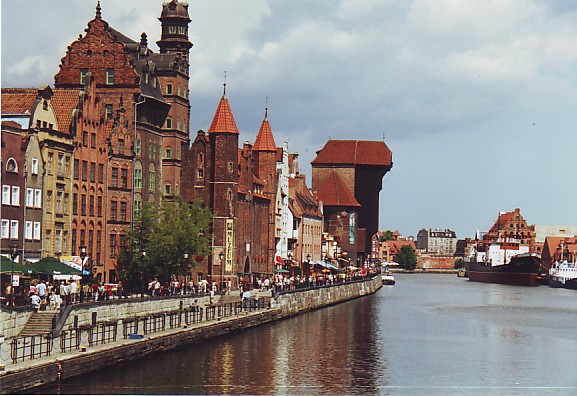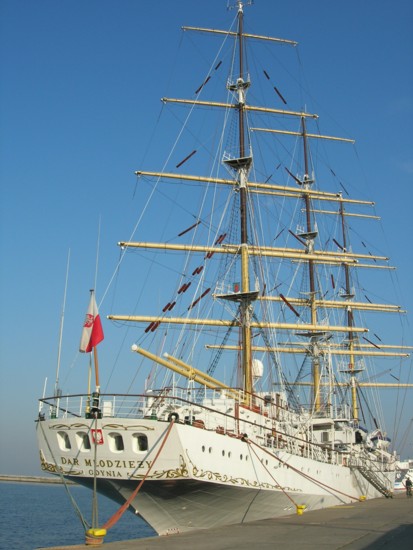East Pomerania
County: Pomorskie

Gdańsk. Długie Pobrzeże street seen from Zielony Most (The Green Bridge)
Location
Poland's northern border is primarily a border with the sea, namely the 524 km long coastline along the Baltic Sea.
In the coastal areas there is a favorable microclimate, characterized by many hours of sunshine and the considerable humidity in the air, which also has a healing content of iodine. Extensive forest areas and the absence of major industrial companies ensure a clean air in the area. Favorable ocean currents still bring new building material to the long sandy beaches.
From the coast and 200 km inland you will find a varied landscape, consisting of lakes, created after the ice age, rivers, forests and hills.
The land area of Poland, which lies on the Baltic Sea – on the stretch from the western border of Poland on the Odra River to the Wisla River – is called Pomerania, in Polish: Pomorze, which means the land by the sea.
The history of the area
Pomorzanie was the name of the largest of the Slavic tribes that originally populated this area.
Historically, the designation of Pomerania encompassed the land that lay along the Baltic coast from the river Recknitz east of Rostock in Germany to the river Wisła. To the east of this river lay Prusy, inhabited by a Baltic speaking people. It is said that the southern border of earliest Pomerania passed along the rivers Notec and Warta, but for most of the Middle Ages and later the boundaries of Pomorze Szczecińskie (western Pomerania) and Pomorze Gdańskie (eastern Pomerania) were somewhat further north.
Today, Pomerania is divided into West Pomerania with Szczecin as the main city and East Pomerania with Gdańsk as the main city in this region.

Training ship “Dar Młodzieży”, Gdynia. – Photo: Jakob Hoffmann
Accommodation
Pomorskie Voivodeship – here practical information for tourists
Also read about accommodation under individual cities in the region.
Eating Out:
Pomorskie Voivodeship – here practical information for tourists
Cities in East Pomerania
Almost all Pomeranian cities have a very ancient history. The oldest of them are of Slavic origin. Some have arisen in connection with princely castles, fortresses belonging to the Crusaders, chivalry castles, royal castles or monasteries. Among them we find fishing villages as well as market towns and among the youngest coastal towns that have arisen as a result of an increasing interest in the healing qualities of water and air.
Also follow the links below for a brief description of the individual cities and towns:
Pomeranian County:
Bytów . -Chojnice . -Człuchów . -Gdańsk . -Gdynia . -Gniew. -Whole. -Kartuzy . -Kościerzyna . -Krynica Morska. -Kwidzyn . -Łeba . -Lębork . -Malbork . -Nowy Dwór Gdański. -Pelplin. -Pruszcz Gdański . -Puck. -Reda . -Rumia . -Slupsk . -Sopot . -Starogard Gdański . -Sztum . -Sztutowo. -Tczew . -Wejherowo . -Władysławowo.
Links to the area
Pomorskie Voivodeship
Crusader castles and bishopric castles in northern Poland
Translated into English by Google Translate. Spangshus.dk accept no liability for any errors or omissions in translation.
Map

Search
Most used tags
churches (205) Castles (86) Monasteries (79) Town walls (74) Lakes (71) Town halls (67) Rivers (65) Castles1 (62) Mansions (55) Museums (51) Regional museums (38) Town gates (36) Abbey churches (35) Castle ruins (30) Cathedrals (26) Forests (25) Health resorts (24) Water sports (23) Mounds (23) National parks (22)Click for all tags
Denne side er også tilgængelig på dansk. This page and contents is (c) Copyright 2018- www.spangshus.dk. Based on Inviator software by ISCA Software